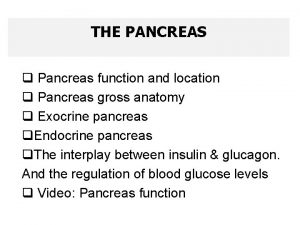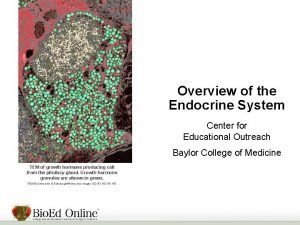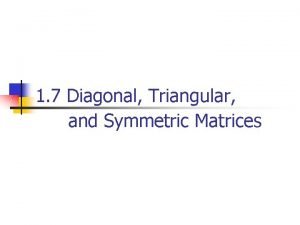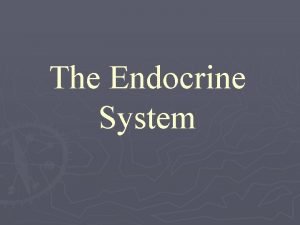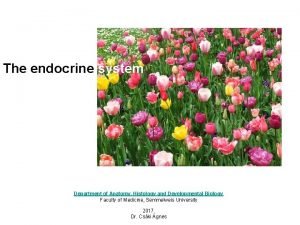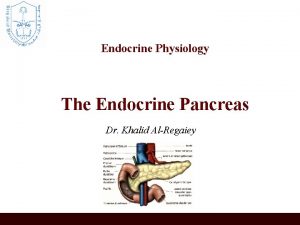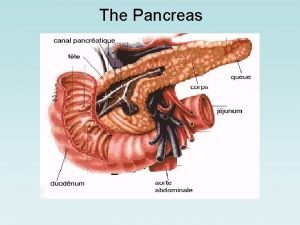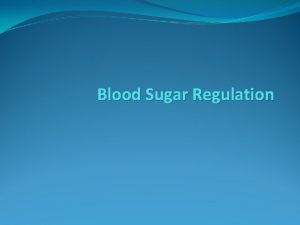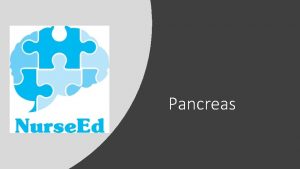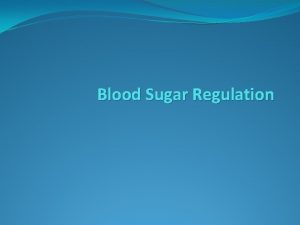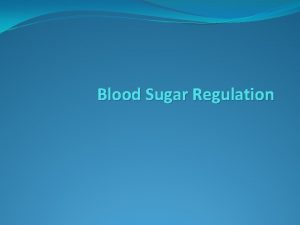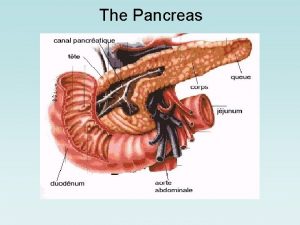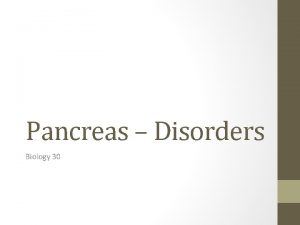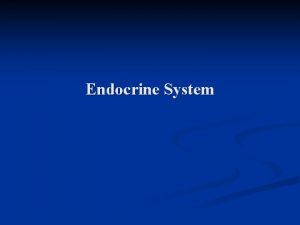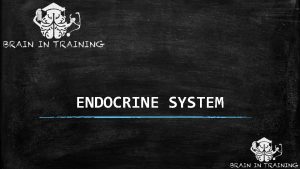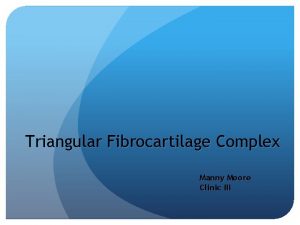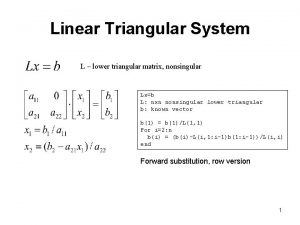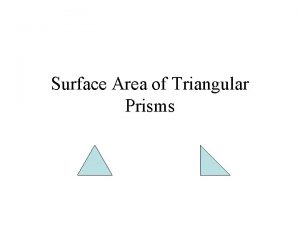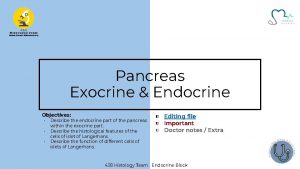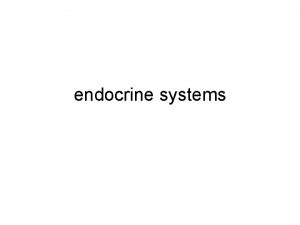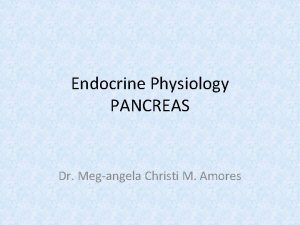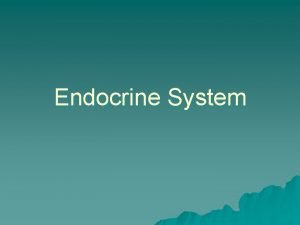Endocrine Physiology The Endocrine Pancreas Pancreas A triangular

















































- Slides: 49

Endocrine Physiology The Endocrine Pancreas

Pancreas • A triangular gland, which has both exocrine and endocrine cells, located behind the stomach • Strategic location • Acinar cells produce an enzyme-rich juice used for digestion (exocrine product) • Pancreatic islets (islets of Langerhans) produce hormones involved in regulating fuel storage and use.

The Endocrine Pancreas

Islets of Langerhans • 1 million islets • 1 -2% of the pancreatic mass • Beta (β) cells produce insulin • Alpha (α) cells produce glucagon • Delta (δ) cells produce somatostatin • F cells produce pancreatic polypeptide

Islets of Langerhans

Insulin • Hormone of nutrient abundance • A protein hormone consisting of two amino acid chains linked by disulfide bonds • Synthesized as part of proinsulin (86 AA) and then excised by enzymes, releasing functional insulin (51 AA) and C peptide (29 AA).

Insulin Structure 1 - Large polypeptide 51 AA (MW 6000) 2 - Tow chains linked by disulfide bonds. A chain (21 AA) B chain (30 AA) 3 disulfide bonds.

Insulin Structure

Protein and Polypeptide Synthesis and Release

Insulin Synthesis • insulin gene encodes a large precursor of insulin (preproinsulin) • During translation, the signal peptide is cleaved (proinsulin) • During packaging in granules by Golgi, proinsulin is cleaved into insulin and C peptide

Insulin Synthesis DNA (chromosome 11) in β cells m. RNA Preproinsulin (signal peptide, A chain, B chain, and peptide C) proinsulin

Insulin Synthesis

Insulin Synthesis • Insulin synthesis is stimulated by glucose or feeding and decreased by fasting • Threshold of glucose-stimulated insulin secretion is 100 mg/dl. • Glucose rapidly increase the translation of the insulin m. RNA and slowly increases transcription of the insulin gene

Glucose is the primary stimulator of insulin secretion



Regulation of Insulin Secretion

Regulation of Insulin Secretion • No insulin is produced when plasma glucose below 50 mg/dl • Half-maximal insulin response occurs at 150 mg/dl • A maximum insulin response occurs at 300 mg/dl • Insulin secretion is biphasic: • Upon glucose stimulation– an initial burst of secretion (5 -15 min. ) • Then a second phase of gradual increment that lasts as long as blood glucose is high

Insulin secretion is biphasic

Insulin Signaling

Insulin Signaling

Insulin Action on Cells: • Insulin is the hormone of abundance. • The major targets for insulin are: • liver • Skeletal muscle • adipose tissue • The net result is fuel storage

Insulin Action on Carbohydrate Metabolism: Liver: • Stimulates glucose oxidation • Promotes glucose storage as glycogen • Inhibits glycogenolysis • Inhibits gluconeogenesis Muscle: • Stimulates glucose uptake (GLUT 4) • Promotes glucose storage as glycogen

Insulin Action on Carbohydrate Metabolism : Adipose Tissue: • Stimulates glucose transport into adipocytes • Promotes the conversion of glucose into triglycerides and fatty acids

Glucose Transport • GLUT 2 (liver, pancreas) • GLUT 4, insulin sensitive transporter (muscle, adipose tissue) • GLUT 3 (brain)

Glycogen Synthesis • Short term storage of glucose • Activates glycogen synthase • Inhibit glycogen phosphorylase • Glycolysis is also stimulated by insulin

Lipogenic and antilipolytic • Insulin promotes lipogenesis and inhibits lipolysis • Promotes formation of α-glycerol phosphate and fatty acid synthesis • Stimulates fatty acid synthase (FAS) • Inhibits hormone sensitive lipase (HSL) • Activates lipoprotein lipase (LPL)

Protein Synthesis and Degradation • Insulin promotes protein accumulation: 1. Stimulates amino acid uptake 2. Increases the activity of protein synthesis 3. Inhibits protein degradation

Action of insulin on Liver:

Action of insulin on Fat:

Action of insulin on Muscle:

Insulin action (summary): Dominates in Fed State Metabolism • glucose uptake in most cells • glucose use & storage • protein synthesis • fat synthesis

Insulin: Summary


Glucagon • A 29 -amino-acid polypeptide hormone that is a potent hyperglycemic agent • Produced by α cells in the pancreas • Its major target is the liver, where it promotes: • Glycogenolysis – the breakdown of glycogen to glucose • Gluconeogenesis – synthesis of glucose from lactic acid and noncarbohydrates • Release of glucose to the blood from liver cells

Glucagon Signaling

SYNTHESIS DNA in α cells m. RNA Preproglucagon

Factors Affecting Glucagon Secretion:

Glucagon Action on Cells:


Insulin & Glucagon Regulate Metabolism

The Regulation of Blood Glucose Concentrations

Diabetes Mellitus (DM) • A serious disorder of carbohydrate metabolism • Results from hyposecretion or hypoactivity of insulin • The three cardinal signs of DM are: • Polyuria – huge urine output • Polydipsia – excessive thirst • Polyphagia – excessive hunger and food consumption

Diabetes Mellitus Type I • Type 1: beta cells destroyed- no insulin produced chronic fasted state, "melting flesh", ketosis, acidosis, glucosurea, diuresis & coma

Diabetes Mellitus: Type II a Group of Diseases • Over 15 million diabetics in USA- 10% type I, 90% type II • More common is some ethnic groups • Insulin resistance keeps blood glucose too high • Chronic complications: atherosclerosis, renal failure& blindness

Diabetes Mellitus: Type II a Group of Diseases

GTT

Symptoms of Diabetes Mellitus

Diabetes Mellitus (DM)
 Lamina propria papillae
Lamina propria papillae Q
Q Baylor
Baylor Pancreas anatomy and physiology
Pancreas anatomy and physiology Pancreas anatomy and physiology
Pancreas anatomy and physiology Transpose of symmetric matrix
Transpose of symmetric matrix Tư thế ngồi viết
Tư thế ngồi viết Thế nào là hệ số cao nhất
Thế nào là hệ số cao nhất V cc
V cc Thẻ vin
Thẻ vin Slidetodoc
Slidetodoc Thơ thất ngôn tứ tuyệt đường luật
Thơ thất ngôn tứ tuyệt đường luật Các châu lục và đại dương trên thế giới
Các châu lục và đại dương trên thế giới Khi nào hổ con có thể sống độc lập
Khi nào hổ con có thể sống độc lập Từ ngữ thể hiện lòng nhân hậu
Từ ngữ thể hiện lòng nhân hậu Diễn thế sinh thái là
Diễn thế sinh thái là Vẽ hình chiếu vuông góc của vật thể sau
Vẽ hình chiếu vuông góc của vật thể sau Tư thế worm breton
Tư thế worm breton Phép trừ bù
Phép trừ bù Lời thề hippocrates
Lời thề hippocrates đại từ thay thế
đại từ thay thế Bổ thể
Bổ thể Quá trình desamine hóa có thể tạo ra
Quá trình desamine hóa có thể tạo ra Công thức tiính động năng
Công thức tiính động năng Sự nuôi và dạy con của hổ
Sự nuôi và dạy con của hổ Thế nào là mạng điện lắp đặt kiểu nổi
Thế nào là mạng điện lắp đặt kiểu nổi Các loại đột biến cấu trúc nhiễm sắc thể
Các loại đột biến cấu trúc nhiễm sắc thể Biện pháp chống mỏi cơ
Biện pháp chống mỏi cơ Vẽ hình chiếu đứng bằng cạnh của vật thể
Vẽ hình chiếu đứng bằng cạnh của vật thể Chúa yêu trần thế
Chúa yêu trần thế Phản ứng thế ankan
Phản ứng thế ankan Thiếu nhi thế giới liên hoan
Thiếu nhi thế giới liên hoan điện thế nghỉ
điện thế nghỉ Tỉ lệ cơ thể trẻ em
Tỉ lệ cơ thể trẻ em Một số thể thơ truyền thống
Một số thể thơ truyền thống Trời xanh đây là của chúng ta thể thơ
Trời xanh đây là của chúng ta thể thơ Số nguyên tố là
Số nguyên tố là đặc điểm cơ thể của người tối cổ
đặc điểm cơ thể của người tối cổ Fecboak
Fecboak Môn thể thao bắt đầu bằng từ đua
Môn thể thao bắt đầu bằng từ đua Hát kết hợp bộ gõ cơ thể
Hát kết hợp bộ gõ cơ thể Các châu lục và đại dương trên thế giới
Các châu lục và đại dương trên thế giới ưu thế lai là gì
ưu thế lai là gì Sơ đồ cơ thể người
Sơ đồ cơ thể người Tư thế ngồi viết
Tư thế ngồi viết Chó sói
Chó sói Cái miệng nó xinh thế
Cái miệng nó xinh thế Mật thư tọa độ 5x5
Mật thư tọa độ 5x5 Major endocrine glands male and female
Major endocrine glands male and female Hypothalamus
Hypothalamus

